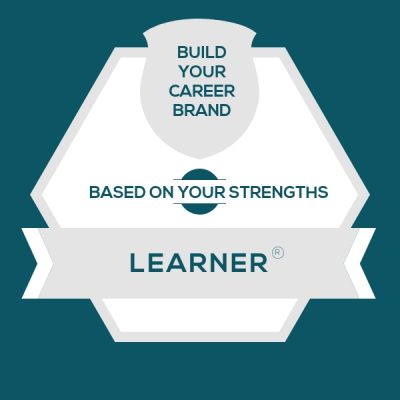Learner Strength: Build A Genuine Career Brand
Podcast: Play in new window
Subscribe: Spotify | iHeartRadio | Email | TuneIn | More
Learner Strength: Get Known For Your Talent
I hear a lot of curiosity about how to apply your CliftonStrengths talent theme of Learner to your career.
In this series, I break down one strength per post — so that you can add to the insights from your StrengthsFinder report and make a better alignment between your job and your strengths.
- If you’re exploring this concept as a manager, use this series for career development ideas and even new clues about responsibilities you could give a person with this talent theme so that they can show up at their best.
- If you’re exploring this concept for yourself, use this as a chance to build a reputation for your strengths so that you’re more likely to be given assignments that live in your strengths zone.
You’ll get three layers to chew on:
1. Career Branding
2. Red Flag Situations At Work
3. Fresh Application Ideas
Career Branding For The Learner Strength
You probably already have a reputation for what you know. Think about your personal resume, CV, or your LinkedIn profile, I bet it's full of “the what,” which are things like job titles, skills, knowledge, expertise, or the degree you earned. What’s missing is usually "the how,” and this is where your StrengthsFinder talent themes live.
Chances are good that you are a lot like my StrengthsFinder training clients, where you don’t physically see your teammates and customers every day. That’s why LinkedIn has become so important for career branding. It’s how your teammates, customers, and vendors go look you up before a meeting - to see who they’re about to talk to. And rather than only telling them what you know, you should also give them a peek at how it is to work with you.
Here are a bunch of adjectives to consider using in your career branding efforts and your LinkedIn profile when you lead through the Learner strength:
- Curious
- Variety Seeker
- Studious
- Lifetime Learner
- Open-Minded
- Expert
- Multi-Passionate
- Inquisitive
- Continuous Improver
- Discoverer
- Dynamic
- Explorer
- Growth-Focused
- Early Adopter
Red Flag Situations When You Lead With The Learner Strength
These are the cultures, interactions, or situations that feel like soul-sucking drudgery to someone with the talent theme of Learner. They might even make you want to quit the team. So I’ll give you a couple of these to be on watch for — because if they fester, you might get the urge to quit the job or become detached and disengaged at work.
Here are a couple of Red flags for the Learner strength (talent theme):
- Stagnation. If you lead through the Learner strength and you stop growing and learning, you will likely feel like you’re dying inside. Use this as an early warning sign. If you’re bored. If you’re stagnant. If you’re assigned to maintain something and keep it the same, you have to find other ways to feed your Learner or you will be super drained.
- Maintenance. Think about the contrast between maintaining something that is already up and running versus being involved in a new project or program. If you’re involved in keeping something at status quo, you will likely have few days that feel energizing. That’s because you love to explore and learn and experience new things. If you own a program that has already launched, be sure that you’re continually working on your craft or your subject matter depth. That way, you can maintain the success while constantly bringing new information or new angles to the team.
3 Fresh Application Ideas For The Learner Strength
These are ways to apply the talent theme of Learner at work , even when the job duties on the team feel pretty locked in. If you’re exploring this concept as a team manager, be sure to have a conversation around these ideas. You’ll both be able to come up with places to apply them.
For someone who leads through the Learner strength, put the talent to good use with one of these options:
- When you need a tester. If you have a change initiative and you need someone to be the early adopter, call on someone with Learner to be your pioneer. Tell them that you’re asking them to test and explore - to soak it all in - and to document the good and bad. They will have fun being on the cutting edge and being the trailblazer for the team.
- When you need to introduce something foreign. Imagine a situation where your team is taking on a whole new set of responsibilities. You’re going to have to ask some people on your team to think or act or learn in a whole new way. Pick someone with Learner and tell them that you’re introducing this to give them some variety and a growth-challenge.
- When you need one person on the team to learn everything there is to know on a topic. Sometimes teams want to be on the cutting edge of an ever-changing competency or subject matter. A project like this might seem insurmountable to the non-Learner. Or it might seem frustrating to a non-Learner because they’re never complete. But to a Learner, this continuous study and growth will be fulfilling.
So there you have it. It’s a quick tour for building your career through the talent theme of Learner.
Here's Your Personal Branding Homework For The Learner Strength
- Go take action on your LinkedIn profile with the career branding section. Challenge yourself to write one sentence in the Summary section of LinkedIn that captures how you collaborate as a teammate at work.
- Then think over the red flags to see if there’s anything you need to get in front of before it brings you down.
- Volunteer your talents through the application ideas. And if you’re a manager, have a conversation with your team members about which of these things sound like something they’d love to have more of.
- Dig into the Learner strength all the way. You can really nerd out on the nuances on the Learner Talent Theme Page.
Here's A Full Transcript Of The 8 Minute Episode
You're listening to Lead Through Strengths, where we help corporate teams apply their greatest strengths at work. I'm your host, Lisa Cummings. And I got to tell you, it's hard to find something more energizing than using your natural talents every day at work. I hear a lot of curiosity about how to apply your CliftonStrengths talent theme of Learner. If you have Learner, you're so curious, always wanting to learn more.
So, in this series, I bet you're learning not just about Learner, but about all the other talent themes as well. If you have this one, you'll get one strength broken down per episode so that you can add to the insights that you already have from your StrengthsFinder report, and then make a deeper match between your job and your strengths.
Now, if you're listening to this, as a people manager, use this series for career development purposes. Be thinking about how to get clues for the kinds of tasks and responsibilities that someone with the Learner talent theme will really thrive in so they can be at their best and most productive at work.
If you're listening for yourself, because you lead through the talent theme of Learner, use this as a chance to consider how you can build your reputation, built on your strengths so that you're more likely to be given assignments that live in your strengths. So, it's like a positive snowball.
Today, the talent theme of the episode, as you already know, is Learner, and you're going to get three layers to chew on. One is career branding. The second is red flag situations at work. And the third is application ideas.
So, let's talk career branding for Learner. You probably already have a reputation for what it is that you know. Now if you think about your resume, your CV, your LinkedIn profile, it's probably full of the ‘what’ things like job titles, skills, knowledge, expertise, the degree you earned. And in fact, if you have the Learner talent theme, there might be a whole lot of ‘what’ because you might feel like you have all sorts of random interests and you want to express this wide curiosity that you have.
Yet still, what's often missing is the ‘how’. This is where your StrengthsFinder talent themes live, though, how you get work done is also one of your key differentiators. And chances are good that you're like a lot of my Strengths Finder training clients where you don't physically see your teammates. You don't see your customers in the flesh every day. That's why LinkedIn has become so important for career branding because those same people, those teammates, customers, vendors, suppliers, they go look you up before meetings because they want to see who they're about to talk to. And then rather than only telling them what you know, you can use this episode to help you give them a peek at how it is to work with you. And a way to do that is by using the summary section in LinkedIn.
So here are a bunch of Learner-related adjectives you can consider using in your career branding efforts and in your LinkedIn profile in that summary section. So here goes curious, variety seekers, studious, lifetime learners, expert, multi passionate, inquisitive, dynamic explorers, growth-focused, and early adopters.
Now let's move to the other side, the red flag situations. These are the cultures, the interactions, the situations that can feel like soul-sucking drudgery to someone with the talent theme of Learner. Instead of putting you at the best, these might be putting you at your worst, to make you want to quit, detach, disengage.
So, a couple of important red flags for Learner.
One, stagnation. If you lead through Learner and you stop growing and learning, if you find yourself getting bored, *early warning sign* or you're gonna feel like you're dying inside. So, use it as the early warning sign that it is when I say red flag, maybe look for the pink flag. Look for when it's starting to go up because if you're bored, if you're stagnant or even as assigned to maintain something, just to keep it the same, ooh, that might not work for you, because you have to find other ways to feed your Learner or you're going to get really drained.
So, I'm not saying just because you're in a job that requires maintenance mode, you should go quit. But you're going to have to find other ways to feed your Learner so that you don't feel the soul-sucking drudgery. Speaking of maintenance, let's talk about that one. That's another red flag. So, you have stagnation, you have maintenance. Let's think about the contrast between maintaining something that is already up and running versus being involved in a new project or a new program.
If you're involved in keeping something at status quo, you're likely going to have few days feeling energized if you lead through Learner. That's because you love to explore. You love to learn. You love to be curious. You love to experience new things. You like variety.
So, if you own a program that has already launched, it's already out there to the world and you're supposed to do keep it going and just keep fixing, seeing anything that breaks as it goes along, you have to be sure that you're continually working on something. Work on another area of your craft. Work on your subject matter depth. Ask if you can make some improvements where you see opportunities for it, or even volunteer to be involved in other projects, so that you can maintain success, but also bring new information, new angles to the team and new learning into your brain because your brain needs to be learning.
Alright, 3 fresh application ideas for Learner. These are ways to apply the talent theme of Learner at work, even when the job duties on the team feel kind of locked in. So, if you're listening as a manager, be sure to have a conversation around these ideas to make sure that they would be valid for the person and then you could come up with places to apply them.
So, I'm going to frame this up as if you're listening through the lens of a manager. But you can also volunteer your talents this way if you have Learner. Alright.
Number one: when you need a tester. So, if you have a change initiative, and you need someone on the team to be the early adopter, call in someone with Learner to be your pioneer. Tell them that you're asking them to test and explore and soak it in and document the good and bad. So, they'll really have fun being on the cutting edge and being the trailblazer for the team.
Second application idea: when you need to introduce something foreign. So, imagine a situation where your team is taking on a whole new set of responsibilities; you had a reorg, some big change, you acquired a company, you're launching a new product. You're gonna have to ask some people on your team to think or act or learn in a whole new way. We'll pick someone with Learner and tell them that you're introducing this project to them in order to give them some variety and in order to give them a growth challenge. And then it will attach the meaning of the variety and the learning and all of that and it will be energizing.
Number three: when you need a person on the team to learn everything there is to know on the topic. I've had this before where the team needs to get up to speed, but you don't want to assign every person to learn everything. And you just say we need one go to soak in everything they can and then share it with others. That's what I'm talking about here. Sometimes teams want to be on the cutting edge of some competency or some subject matter. Or you might have something brand new. And oh, there's like a project that seems insurmountable to others, because there's so much to hurry up and learn, especially to the non-Learner talent people. Or it might seem frustrating to someone who doesn't have a Learner talent because they're never finished.
You know, you're not, you're never complete as a person. But Learners think it's fun - always becoming, always learning, always growing. So, this big study, this continuous study kind of thing and this growth, that'll be really fulfilling for them.
So, there you have it, it's a quick tour for building your career through the talent theme of Learner. So, the homework is: go take action on your LinkedIn profile with the career branding section. Challenge yourself to write one sentence. That's it just one sentence in the summary section to capture how you collaborate as a teammate at work.
Second, think over the red flags. See if there's anything you need to get in front of before it starts bringing it down with those energy tickers.
And then finally, volunteer your talents through those application ideas. And if you're listening from the lens of a manager, have a conversation with a team member about how you could volunteer those talents and put those to work tomorrow.
With that, I'm your host Lisa Cummings from Lead Through Strengths. Now, if you're thinking about doing a virtual or in-person event to kick off a more formalized strengths focused culture, just head over to leadthroughstrength.com/training . Check out the current offerings and see if we look like we might be a good fit for you.
With that, until next time. Thank you for being part of this powerful movement that helps people unleash the awesomeness that they already have inside them.
Carmie is a professional writer and editor at Lead Through Strengths. Having spent 8 happy years with a nonprofit child organization as a storyteller and sponsorship relations team manager, she continues collaborating with others across the globe for the joy of human development and connection. Her days are powered by coffee, curiosities, cameras (film and digital), music, notebooks, and a cat. Where books are home, she’s home. She calls her Top 5 StrengthsFinder Talents “CLIPS” (Connectedness, Learner, Intellection, Positivity, and Strategic)–you know, those tiny objects that hold connected things together. She’d like to think she’s one.


